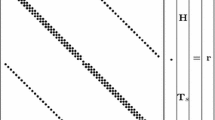Abstract
A generalized enthalpy-based equation of state, which includes thermal electron excitations and non-equilibrium thermal energies, is formulated for binary solid and porous mixtures. Our approach gives rise to an extra contribution to mixture volume, in addition to those corresponding to average mixture parameters. This excess term involves the difference of thermal enthalpies of the two components, which depend on their individual temperatures. We propose to use the Hugoniot of the components to compute non-equilibrium temperatures in the mixture. These are then compared with the average temperature obtained from the mixture Hugoniot, thereby giving an estimate of non-equilibrium effects. The Birch–Murnaghan model for the zero-temperature isotherm and a linear thermal model are then used for applying the method to several mixtures, including one porous case. Comparison with experimental data on the pressure–volume Hugoniot and shock speed versus particle speed shows good agreement.


















Similar content being viewed by others
References
Trunin, R.F.: Shock Compression of Condensed Materials. Cambridge University Press, Cambridge (1998)
Davison, L.: Fundamentals of Shock Wave Propagation in Solids. Springer, Berlin (2008)
Zeldovich, Y.B., Raizer, Y.P.: Physics of Shock Waves and High-Temperature Hydrodynamic Phenomena, Vol -II. Academic, New York (1967)
Kapila, A.K., Menikoff, R., Bdzil, J.B., Son, S.F., Stewart, D.S.: Two-phase modeling of deflagration-to-detonation transition in granular materials: reduced equations. Phys. Fluids 13, 3002–3024 (2001)
Duvall, G.E., Taylor, S.M.: Shock parameters in a two component mixture. J. Compos. Mater. 5(2), 130–139 (1971)
Krueger, B.R., Vreeland, T.: A Hugoniot theory for solid and powder mixtures. J. Appl. Phys. 69(2), 710–716 (1991)
Gavrilyuk, S.L., Saurel, R.: Rankine–Hugoniot relations for shocks in heterogeneous mixtures. J. Fluid Mech. 575(1), 495–507 (2007)
Dremin, A.N., Karpukhin, I.A.: Method of determination of shock adiabat of the dispersed substances. Zhurnal Prikladnoi Mekhaniki i Tekhnicheskoi Fiziki 1(3), 184–188 (1960). (in Russian)
Alekseev, YuF, Al’tshuler, L.V., Krupnikova, V.P.: Shock compression of two-component paraffin–tungsten mixtures. J. Appl. Mech. Tech. Phys. 12(4), 624–627 (1971)
Saurel, R., Le Metayer, O., Massoni, J., Gavrilyuk, S.: Shock jump relations for multiphase mixtures with stiff mechanical relaxation. Shock Waves 16(3), 209–232 (2007)
McQueen, R.G., Marsh, S.P., Taylor, J.W., Fritz, J.N., Carter, W.J.: The Equation of State of Solids from Shock Wave Studies. In: Kinslow, R. (ed.) High Velocity Impact Phenomena, pp. 293–417. Academic, New York (1970)
Batsanov, S.S.: Effects of Explosions on Materials: Modification and Synthesis Under High-Pressure Shock Compression. Springer, Berlin (1994)
Petel, O.E., Jette, F.X.: Comparison of methods for calculating the shock hugoniot of mixtures. Shock Waves 20, 73–83 (2010)
Zhang, X.F., Qiao, L., Shi, A.S., Zhang, J., Guan, Z.W.: A cold energy mixture theory for the equation of state in solid and porous metal mixtures. J. Appl. Phys. 110(1), 013506-1–013506-10 (2011)
Zhang, X.F., Shi, A.S., Zhang, J., Qiao, L., He, Y., Guan, Z.W.: Thermochemical modeling of temperature controlled shock-induced chemical reactions in multifunctional energetic structural materials under shock compression. J. Appl. Phys. 111(12), 123501-1–123501-9 (2012)
Rice, M.H., Walsh, J.M.: Equation of state of water to 250 kilobars. J. Chem. Phys. 26, 824–830 (1957)
Wu, Q., Jing, F.: Thermodynamic equation of state and application to Hugoniot predictions for porous materials. J. Appl. Phys. 80(8), 4343–4349 (1996)
Boshoff-Mostert, L., Viljoen, H.J.: Comparative study of analytical methods for Hugoniot curves of porous materials. J. Appl. Phys. 86(3), 1245–1254 (1999)
Nayak, B., Menon, S.V.G.: Explicit accounting of electronic effects on the Hugoniot of porous materials. J. Appl. Phys. 119(12), 125901–125907 (2016)
Kormer, S.B., Funtikov, A.I., Urlin, V.D., Kolesnikova, A.N.: Dynamic compression of porous metals and the equation of state with variable specific heat at high temperatures. Sov. Phys. JETP 15(3), 477–488 (1962)
Carroll, M.M., Holt, A.C.: Static and dynamic pore-collapse relations for ductile porous materials. J. Appl. Phys. 43(4), 1626–1636 (1972)
Walsh, J.M., Christian, R.H.: Equation of state of metals from shock wave measurements. Phys. Rev. 97(6), 1544–1556 (1955)
Marsh, S.P.: LASL Shock Hugoniot Data. University of California Press, California (1980)
Bushman, A.V., Lomonosov, I.V., Khishchenko, K. V.: Shock wave data base. (2004). http://teos.ficp.ac.ru/rusbank. Accessed 25 Mar 2017
Birch, F.: Elasticity and constitution of the Earth’s interior. J. Geophys. Res. 57(2), 227–286 (1952)
Vinet, P., Smith, J.R., Ferrante, J., Rose, J.H.: Temperature effects on the universal equation of state of solids. Phys. Rev. B 35(4), 1945–1953 (1987)
Vinet, P., Rose, J.H., Ferrante, J., Smith, J.R.: Universal features of the equation of state of solids. J. Phys. Condens. Matter 1(11), 1941–1963 (1989)
Hama, J., Suito, K.: The search for a universal equation of state correct up to very high pressures. J. Phys. Condens. Matter 8(1), 67–81 (1996)
Young, D.A., Corey, E.M.: A new global equation of state for hot, dense matter. J. Appl. Phys. 78(6), 3748–3755 (1995)
Burakovsky, L., Preston, D.L.: Analytic model of the Grüneisen parameter for all densities. J. Phys. Chem. Solids 65(8–9), 1581–1587 (2004)
Acknowledgements
The authors thank the reviewers and editor of Shock Waves for critical reviews and suggestions to improve the presentation of the paper.
Author information
Authors and Affiliations
Corresponding author
Additional information
Communicated by D. Ranjan and A. Higgins.
S. V. G. Menon retired from Bhabha Atomic Research Centre, Mumbai.
Rights and permissions
About this article
Cite this article
Nayak, B., Menon, S.V.G. Non-equilibrium theory employing enthalpy-based equation of state for binary solid and porous mixtures. Shock Waves 28, 141–151 (2018). https://doi.org/10.1007/s00193-017-0717-9
Received:
Revised:
Accepted:
Published:
Issue Date:
DOI: https://doi.org/10.1007/s00193-017-0717-9




